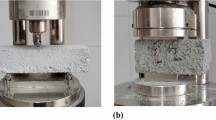Abstract
Both mechanical compaction and addition of pozzolanic silica fumes can provide low permeability interfacial transition zones around the fibers which reinforce a mortar matrix. This paper deals with the controversial effect of achieving a higher matrix compactness and its influence on the fracture behaviour of a mortar reinforced with amorphous cast iron fibers. Test were conducted in uniaxial tension on notched composite mortar prisms in order to plot load versus crack opening curves and evaluate the bridging energy provided by the fibers across a single opening crack. These measures were correlated to SEM observations of the microstructure of fiber/mortar interface, depending on the compaction energy and/or the mortar composition. It is relatively difficult to establish a compromise between ductility and high performance in terms of durability for the material system tested. Indeed, fibers were pulled out of low compactness mortars exhibiting large porous interfacial transition zones (ITZs) along the fiber surface. These zones mainly comprised fibrillous CSH, ettringite and large portlandite crystals. Conversely, when the ITZs around the fibers where filled with compact CSH, resulting from the pozzolanic reaction between silica fume and portlandite, no fiber slippage was observed, but the reinforced mortar broke in a quasi-brittle manner.
Similar content being viewed by others
References
Rossi, P.,'Mechanical Behaviour of Metal-fibre Reinforced Concretes'. Cement and Concrete Composites 14, 1992, 3-16.
Mobasher, B. K., Ouyang, C. and Shah, S. P.,'Modelling of Fiber Toughening in Cementitious Materials Using an R-curve Approach'. International Journal of Fracture 50, 1991, 199-219.
Maji, A. and Shah, S. P., 'Process Zone and Acoustic-emission Measurements in Concrete'. Experimental Mechanics, March 1998, 27-33.
Wang, Y., Li, V. C. and Backer, S., 'Tensile Failure Mechanisms in Synthetic Fibre-reinforced Mortar'. Journal of Materials Science 26, 1991, 6565-6575.
Obla, K. H. and Li, V. C., 'A Novel Technique for Fiber-matrix Bond Strength Determination for Rupturing Fibers'. Cement and Concrete Composites 17, 1995, 219-227.
Rossi, P., Harrouche, H. and Le Maou, F., 'Comportement Mécanique des Bétons de Fibres Métalliques Utilisées dans les Structures en Béton Armé et Précontraint'. Annales de l'ITBTP 479bis (série matériaux 73), 1989, 165-183.
Brenet, P., Conchin, F., Fantozzi, G., Reynaud, P., Rouby, D. and Tallaron, C., 'Direct Measurement of the Crack Bridging Tractions, a New Approach of the Fracture Behaviour of Ceramic-ceramic Composites'. In JNC 9 Proceedings, J. P. Favre and A. Vautrin (eds.), Vol. 1, 22-24 Nov. 1994, AMAC, 1994, Vol. 2, 1073-1082.
Visalvanish, K. and Naaman, A. E., 'Fracture Model for Fiber Reinforced Concrete'. ACI Journal, Technical Paper, March-April 1983, 128-138.
Li, V. C. 'Non-linear Fracture Mechanics of Inhomogeneous Quasi-brittle Materials'. In Non Linear Fracture Mechanics. M. P. Wunk (ed.), C.I.S.M., Vol. 314, 1990, pp. 143-191.
De Gillebon, B. and Shom, J. M., 'Metallic Glass Ribbons-A New Fibre for Concrete Reinforcement, Developments in Fibre Reinforced Cement and Concrete'. Proceedings RILEM Symposium, Vol. 12, 1986, University of Sheffield.
Burgun, D. and De Guillebon, B., 'Béton projeté renforcé de fibres de fonte-Application à la Rhéabilitation d'un Collecteur d'Assainissement à Nancy'. Techniques Sciences et Méthodes 1, 1987, 19-26.
Redon, C., Morphologie et comportement mécanique de bétons renforcés par des fibres de fonte amorphe. Thèse de Doctorat of the University of Caen, University of Caen (France), 1997.
Redon, C., Chermant, J. L. and Quenec'h, J. L., 'Fiber Pull-out Tests and Microstructure of Fiber/Mortar Interface in Fiber Reinforced Mortars'. In Proceedings of the International Symposium on Brittle Matrix Composites 5. A. M. Brandt, V. C. Li and I. H.Marshall (eds.), Warsaw, Poland, 13-15 Oct. 1997, pp. 64-73.
Barhoghel-Bouny, V., Caractérisation des Pâtes de Ciments et des Bétons, Méthodes, Analyse, Interprétation. LCPC, Paris, 1994.
Regourd, M., L'hydratation du ciment portland. In Le Béton Hydraulique. Presses de l'ENPC, Paris, 1992, pp. 193-221.
Dron, R. and Voïnovitch, I. A., 'L'activation hydraulique des laitiers, pouzzolanes et centres volantes'. In Le Béton Hydraulique. J. Baron and R. Sauterey (eds.), Presses des Ponts et Chaussées, Ch. 13, 1982, 237-245.
Garcia-Diaz, E., Réactivité pouzzolanique des métakaolinites: corrélations avec des caractéristiques minéralogiques des kaolinites. Thèse de Doctorat de l'Ecole Supérieure des Mines de Saint-Etienne et de l'Institut National Polytechnique de Grenoble (France), 1995.
Brandt, A.M., Cement-based Composites, Materials, Mechanical Properties and Performance. E. & F.N. Spon, Chapman & Hall, 1st ed., 1995.
Bentur, A. and Mindess, S., Fiber Reinforced Cementitious Composites. Elsevier Applied Science, distributed by Chapman & Hall, 1990.
Barnes, B. D., Diamond, S. and Dolch, W. L., 'Micromorphology of the Interfacial Zone around Aggregates in Portland Cement Mortar'. Journal of the American Ceramic Society 62, 1979, 21-28.
Rossi, P., 'Mechanical Behaviour of Metal-fibre Reinforced Concrete'. Cement and Concrete Composites 14, 1992, 3-13.
Debicki, G., Contribution à l'étude du rôle de fibres dispersées anisotropiquement dans le mortier de ciment sur les lois de comportement. Les critères de résistance et la fissuration du Matériau. Thèse de Doctorat of the INSA of Lyon and of the University Claude Bernard Lyon I (France), 1988.
Redon, C. and Chermant, J. L., 'Damage Mechanics Applied to Concrete Reinforced with Amorphous Cast Iron Fibers, Concrete Subjected to Compression'. Cement and Concrete Composites 21, 1999, 197-204.
Li, V. C., Wu, H. C. and Chan, Y. W., 'Effect of Plasma Treatment of Polyethylene Fibers on Interface and Cementitious Composite Properties'. Journal of American Ceramic Society 79, 1996, 700-704.
Author information
Authors and Affiliations
Rights and permissions
About this article
Cite this article
Redon, C., Chermant, JL. Compactness of the Cement Microstructure Versus Crack Bridging in Mortars Reinforced with Amorphous Cast Iron Fibers and Silica Fumes. Applied Composite Materials 8, 149–161 (2001). https://doi.org/10.1023/A:1011245515368
Issue Date:
DOI: https://doi.org/10.1023/A:1011245515368




